Saturday, May 10, 2008
Title: Work/work/work
"Way too much work"
Video installation representation of the symbolic meaning of a Buddhist Stupa
Title: Work/work/work
"Way too much work"
Posted by Unknown at 4:00 PM 0 comments
Labels: Art, computers, Video, Work habits
Lets forget that I haven't uploaded anything here for several months and enjoy the fact that I'm back at work with my blog. There are many reasons why I haven't worked here, depression, work, procrastination, graduation, family, friends, relationships and what have you. Some fun and some not so much, and it seems like a hassle and of no particular interest to explain them all. So lets get on with business!
So, what I have been up to? The most important thing right now has been working with my graduation. I'm currently taking two video classes and polishing up (at least trying to polish) my Path to Enlightenment video. Also I'm debating on the purpose of having two blogs. Right now I don't know what I should make each one about. As its stands right now my video-place blog is rather empty and I would prefer to use it for videos, and personal stuff. However my stupas in video already has content and is more polished (here I go... using the same word twice). So until I decide what I want to do with my video-place blog I'll just use it only0 to cross post videos from blip , and this one will serve as a "base of operations" for my blogging needs. Also I've uploaded a few videos to blip recently so I'll start cross posting them to my blogs as soon as possible.
Oh! And to all who may be reading: The Master of Fine Arts exhibition reception is tonight at 6pm in the OSU Urban Arts Space. And the opening of the Bachelors of Fine Arts Exhibition (in which I'll be a part of) will be June 7th between 3pm and 9pm at the OSU Urban Arts Space and several other campus sites (I'll give more information about it as we go along).
Posted by Unknown at 3:10 PM 0 comments
Labels: blogging, Exhibition, Graduation, Work habits
Posted by Unknown at 11:34 AM 0 comments
Labels: Video
Well I'm finally done with the video. At least that's how it should feel like. I had much more planned with this video but I ended up doing a more simplified version of it. Several of the things that didn't occur were to incorporate several of the stupa designs into the video and create a sort of explanation of their symbolism. A few other things that I feel are either missing or not as polished are the sound, the incorporation of the images into the stupa and the overall movement of the camera. Well that needs to get worked on as soon as possible I guess. Now, don't think that just because there are things that I felt are unfinished that the video isn't any good. For example I do feel that both the interior of the stupas and the images by themselves are quite good. Also the 3D model of the stupa itself is not that bad. I'll be posting the video very shortly to Blip.tv, hopefully to Youtube as well so that everyone can see what I mean by all this.
So whats left to do? Well my break between quarters start very soon so I'll be spending more time polishing up the video, and submitting it to different shows. Oh wait did I tell y'all that I finnaly ! Ha! I'm giddy just to try them out at my computer. Also I need to finish my installation for the video! aaaah! Artwork. So much stuff to do so little time.
Posted by Unknown at 11:16 AM 0 comments
Labels: Art, Installation, Stupas
Here you go friends and fellow blog readers, this here is the flyer of the Winter Art and Technology Exhibition where I will have my video in one of the reels.
I have a feeling that the artwork this quarter will be quite awesome so make sure to come early to get some of the free food before watching all of the artwork.
Posted by Unknown at 12:14 AM 0 comments
Labels: Art, Art and Technology, Exhibition, Video
Well the work is not coming out as fast as I had hoped for. But here we have two more images of 60 that need to be made, and animated in a space (yet to be made and animated itself) that I uploaded to Flickr.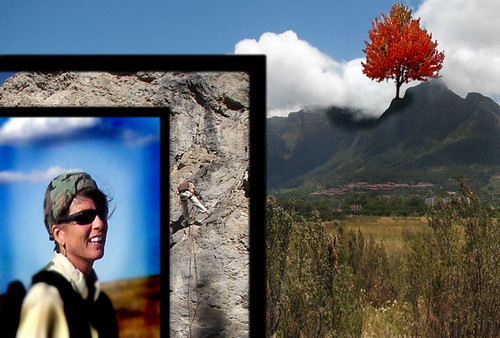
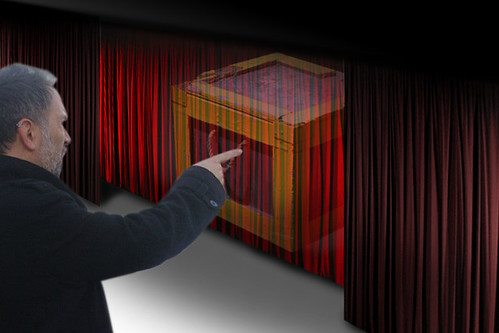
I need food right now, so explanations will come later on.
Ps. If anyone out there has a time machine they would be willing to lend, please send an email to stupasinvideo@yahoo.com. I need to go back in time so I can either work in secret and finish the video, or I to kick my past self in the butt and tell him to get to work.
Posted by Unknown at 11:00 PM 0 comments
Its Crunch time!
Indeed my friends and fellow readers, it's crunch time. The project is officially due next week and it needs to get done no matter what. Depression, anxiety, stress, life's problems can all go to wherever they're supposed to go because they can no longer stay here. This needs to get done. So what does that mean for you? Well, ironically, it means I have stuff to show you about my project.
Right now I've uploaded a series of sketches for the images that are going to be used in the video. Here's an example of one of the sketches (page 4)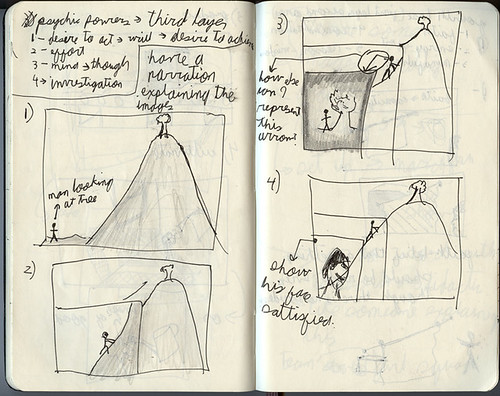
As I found through my research, each level of a Tibetan stupa represents a series of practices that help you reach enlightenment (Bodhipakkhiya Dhamma or Shichika Sanjushichidohon). These are the sketches for these practices. On this page I have the images that represent the cattaro iddhipada, which are desire to act, effort, mind and investigation.
I also uploaded three of the finished images: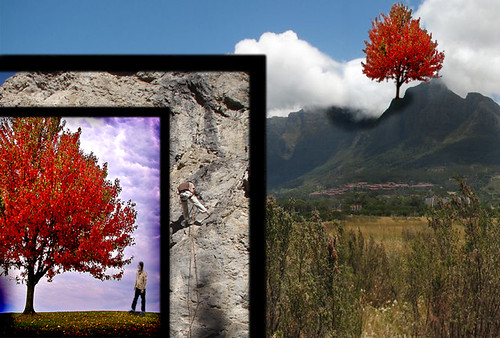
This is actually the third cattaro iddhipada: Thought.
Posted by Unknown at 12:46 PM 0 comments
For those of you who noticed the odd del.icio.us link I put up recently... Kudos! It stands out like a sore frostbitten thumb in a sea of scrumptious glazed raised twist donuts (I'm a donut fan). So why did I put a post about depression in a art blog. Well you might have noticed the infrequency of some of my posts. And for those of you that know me, you would also know about my lack of progress in my project. Personally, I found her description of her situation surprisingly familiar to mine.
Posted by Unknown at 1:13 PM 0 comments
Labels: Depression, Work habits
Hello, I'm finally back in business. My last few posts have not been project based, and this one's not going to be different. The reason for this? Well, firstly, there is the issue that there has not been much progress made, mainly due to a combination of senioritis, depression, and stress. I really don't want to bore you with details and ranting about my deficiencies as to why I am not working as hard as I should. It's just happening and I need to get over it.
Do you remember that post from February 16th??? I do. And I remember that I needed to explain how I modeled my objects. Well I'll give you the basic rundown of the overall process. Hopefully no one will get lost. To create my models I generally use a cube inside a hypernurb and mold and extrude the shape I want out of that. Ok, let me explain how a hypernurb works, because i hope you already know what a cube, extrude, and mold mean. A hypernurb takes a shape (in most of my cases a cube) and smothes the edges of the object.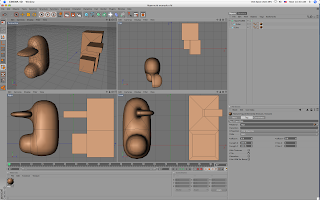
The object on the left is in a hypernurb the one on the right is not.
I you look at the box that says objects, you can see the first cube is in a way inside the hypernurb. This tells you that this object is affected by the parent object (the hypernurb). The other cube object (the one on the right) is actually the same one as the left one only this one is not placed on the hypernurb. The reason I prefer working with these specific tools is that they let me create a single object that can be the animated with less trouble.
Posted by Unknown at 9:14 PM 0 comments
Blue. Red. Green. Three colors we are all familiar with. Not only are we familiar with them but also we are familiar with what they may represent:
Blue – The sky, the sea, sadness, coldness.
Red – Fire, blood, warmth, passion.
Green – Nature, money, envy, hope.
As I grew up, I knew these meanings, but because the political parties back home in Puerto Rico used these colors to represent themselves, whenever I see the colors blue, red, and green next to each other I also think of politics. Personally, I find situations such as this one fascinating because it means that the way someone interprets the meaning of an object or image depends on their own experiences. It is as though the object changes depending on who is watching it. To me these three colors represent politics, fanaticism, insults and mudslinging. On the other hand if I didn’t have these experiences I would simply relate this combination of colors to color theory or television.
So I have dedicated my art to trying to understand this situation of multiple meanings behind an object, image or idea. For example, one of the concepts I have worked with is how our sense of identity is formed and what shapes it. I believe that as our identity or personality changes parts of them are in conflict with each other in a push and pull for dominance or balance. This struggle makes it difficult for an individual to explain who he/she really is. I dealt with this issue more clearly in my “Dos en Uno” video. The video deals with the idea of duality in my personality through the use of objects such as food, seasonings, books, etc. that act like symbols of the parts of my personality that are in conflict. Each object is paired with another one of a similar type (salt with adobo, art theory books with art manuals, etc.) and the movement between each object on the image would represent the coming and going between the two sides of my personality.
To me one of the most important aspects of art is the transmission of a concept to a viewer. However having to deal with this situation that a single image can have several meanings depending on who the viewer is makes the process of transmitting my idea much more complex. Because of this problem present in conveying a message I believe that I should use my art to instruct the viewer about how we perceive things. One of the things I do in my videos is to bring to the forefront aspects of their lives that people wouldn’t normally notice. For example the topic of my video “Details” is to present the sensation that when we are surrounded by an excess of information we lose sight of the details. The video consisted of showing a song and a piece of ice on the floor and as the view changes to a higher angle (where one should see more) the sound becomes more cacophonous and the image becomes overwhelmed by a stream of abstract geometric objects until the viewer can’t see or hear anything. By the end, the scene returns to the detail shot and the song all in focus.
I want my artwork to show people that our identity is fashioned of different aspects whose meanings change depending from which perspective we see them. I want my art to show that when it down comes to the images we see, their meaning go beyond what we can interpret from our own experiences. I want to let people grasp what they take no notice of.
Posted by Unknown at 9:49 AM 0 comments
Labels: Art, Artist Statement, Video
Its kinda funny how you get teased as a little boy as four-eyes when you wear glasses. But if you think about it the math doesn't work well here. You would think that if you lost one eye you would have three to replace them not two. And that if you lost two you would still be able to use the other two. Right?
Well, apparently I abused my glasses so much that they decided to break and leave my with one less eye to use. But like I said the math here is different. If the four-eyed man loses one of his eyes, he loses two. So now I am back to being a two-eyed man.
The two-eyed man.
Actually its funny how they broke. Apparently instead of placing them on the table or nightstand they fell between the bed and my makeshift footboard, and (at least I'm guessing this is what happened) this must have weakened the frame. I say weakened, not broken, because when I found them they were all right. That is until a few hours later when the the frame that holds the lens in place just snaps in two, letting my lens fall to the floor.
I know... I know... Dreadful and I just know you are all asking yourself the same things as I. How will the poor artist keep going with just two of his eyes instead of four? Aren't the visual arts, visual? Won't the artist be impeded by this impediment? Well... I hope not. Hopefully, I'll be able to make new ones tomorrow and thankfully I still have the old lenses back at my place. So, the two-eyed man will become four-eyed soon enough and work will keep on going. This will not stop the artist on his endeavor to finish his video-installation about the symbolism of a Buddhist stupa. The only thing it will do is give an incredibly bad headache, less money, less time to work on work (study/art projects) and a funny story to tell.
Posted by Unknown at 11:07 AM 2 comments
After the interest from people as to how the model I think I'll dedicate a few of my posts to explaining how I made few of my models. Lets start by doing a short and sweet explanation of 3D modeling. No technical stuff here, just the bare bones of what a 3D model is.
First how many of you know what a CG/3D model is? No one, what a shame. Well a good way to describing what a 3D model is, (at least for me) is to compare them to ceramics. To create a ceramic vase or figure you need some raw material to work with, namely clay. Then with a set of tools you shape this material, into a specific form. Well in 3d modeling the process is rather similar. The way the program works is that it acts like a digital sculpture room, or a digital/algorithmic potter's wheel. In the program your objective then is to create a three dimensional object that is made out of digital stuff (1's and 0's) instead of being composed of real stuff (atoms). As a side note, there are companies out there with printers that take these digital objects and make them into real life objects, called rapid prototypes, so the idea that the 3D model is simply digital or "not real" is a complex one. And just like in ceramics where you can create a vase by either hand building it by using coils or making it in a potter's wheel, the options of creating a specific object in 3D modeling software varies in technique and complexity.
Lets introduce you now to what this software looks like:
Cinema 4d. 3d modeling/animating software.
Now of this is a "digital sculpture room" like I said before there are a few things that have to be present. The first one is the room itself where the sculpture is present. This are the four squares (viewports) at the center of the image. Each square gives a different viewpoint of the "digital room" and lets the artist look around the space and the object like they would in real life (imagine the modeler/animator as a mechanic that needs to look underneath a car to fix it).
The Digital room. The place where the work gets done.
Another thing that seems missing from the "digital sculpture room" is the artist. Well the artist is outside the image, sitting on a chair, but this obviously doesn't stop him/her from manipulating or getting hands on with the objects you see on the four squares. For this they employ the tools that you see on the toolbars (yeah I'm referring to those icons or images you see) to the top and the left. Some of the things here act like hands that let you move things around, others let you stretch or shape the object in different ways, and others even let you add more materials to the scene (like a ceramicist that realizes that they need more clay).
The toolbars... I know of at least 4 ways of accessing each function the images represents
To the right you see a box that says "Objects" and has a list object underneath. Well any responsible artist has a list of their material they are using so here's your digital one. And underneath that you see a box that says "Attributes". Well this space tells you some details of what object you have selected, like the position of the object, its size, etc.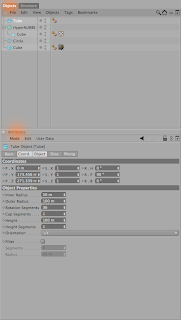
Lets recap. By now I've covered where the objects are, where the artist is, where their tools are and where they get information about their objects. And I still haven't even told you how you would do the actual work! Amazing! Well lets talk more about that some other time. Right now I need some domestic iussues to take care of (did you know that if you don't eat you get hungry and can't work as effectively? Well I keep forgetting that).
Well I'll say! That story board video is taking its time! The reason is that I have to fix each image so that it looks well on the video (yeah, yeah, I know people may say that I suck at drawing but that's really not the point here). So that's coming slowly.
But, I did start my work on the models of the three stupas I'm using on the video. I've already uploaded on Flickr two images of the first stupa I started working on.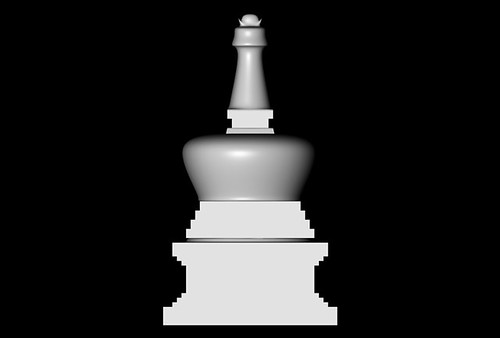
This is the first render I made of the model of the Tibetan stupa. The reason it looks black and white is because it doesn't have any texture (or colored light for that matter). I find this image useful because it lets me see the lighting on it more easily. The lighting scheme is a three point lighting scene, with a main light on the front left (your left), a spot light on the back for highlights, and a filler light on the right.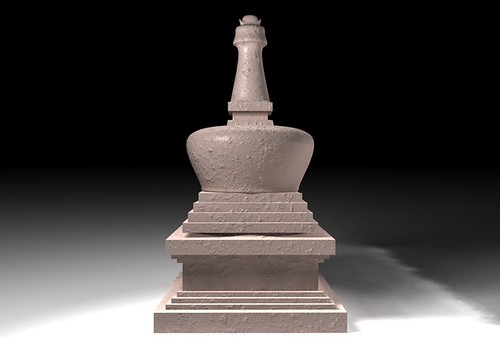
This is the second render of the model. This one has a simple bump map texture with some color added. Even though you can see most of the shadows and highlights the previous one, it just doesn't feel right without some sort of texture on the model. I'm not planning on leaving the texture as it looks right now, though truth be told I don't know what approach I'll go with it. I think I can go either with a more cell shaded look or a more realistic texture for the model... ah options.
Actually there are several things I have to fix in the model itself to make it look more authentic. For example the spire needs a lot more work to get the curves and details in order (the curved pointy thing at the top is supposed to be a crescent moon... yeah I know... not there yet). But overall it looks pretty well for just two days of work. Actually I threw out the model I started yesterday and I started this one at 6:00 am today.
Right now I'm waiting for a flyby video of this model to render. For those of you who don't know, rendering is a lot like watching grass grow, only the grass is a video. So this post has been a welcome relief from the potential mental breakdown I might have from watching the render of my video.
So lets see what do I owe you? The storyboard video, the flyby and I think a post about computer modeling seems in order (specially after my "render" rant). If anyone out there has any doubts, questions, inquiries, or are just plain interested in anything about the project, the process of making a video or how I stay sane in a computer lab just leave a comment and I'll try to answer to the best of my ability.
Before I start with the post itself, a question, if I may: Ever had the problem that you start a post and leave it for a day or two and when you come back to it you find that the energy you thought was present in the post... just... suddenly disappeared? And then, when you try to keep working on it, you start deleting all the phrases you though were good, and the post goes from good to bad to "Oh my God! where's my post, I lost it in all these words!!" Well it happened with this post so I had to restart it from scratch.
Now back to the topic at hand: Research.
Well, I don't know about you but this material I'm using to create my video installation isn't coming from nowhere. Actually I didn't know anything about stupas before I took my Asian history of art class, so I was pretty much had no knowledge on the subject. So I asked a professor in the history of art
department if he knew any good material to learn more about Buddhist
stupas and he recommended this book from Lama Anagarika Govinda called:
Psycho-cosmic Symbolism of the Buddhist Stūpa. And here is when the issues start. If you don't feel the even slightly overwhelmed by the title or the author's name there's something wrong with you. Of course this isn't a problem, it's just more of a sign of issues to come. One of the problem that I had was that I had to catch up on a lot of material that the book takes for granted the reader knows. Which in my case is pretty much the core concepts of Buddhism and its history. But I think that the main problem was translating the ideas he put forth and finding what sort of material I could use to represent visually in the installation. But either way it was a book of great help for me and if anyone out there wants to learn more about these structures this is a great book to read. Actually quite a bit of the stuff you see posted on the internet about Stupas comes from this book.
I think I'll leave this post here as I can feel it draining my powers from me and leaving me with less time time to work on this project. Right now, I think I'll start with the models of the three stupas I'll be using in the video.
Posted by Unknown at 10:23 AM 0 comments
Hey! How's it going? It's the fifth week of class and the stress is mounting! Before I go any further I think that I'll give a run down of the stuff going on the blog so that none of you miss anything.
Firstly you can see I am trying to keep you updated through twitter. So for those of you Twitterites out there, you can subscribe to my account to be updated as the work goes along. And talking about subscribing, if you want to stay on top of new posts the best way is to subscribe to the RSS feed on the right. You just need to subscribe to a feed reader such as Google Reader (did I tell you it's free?) to have a place where to read the feed from.
So that there is no confusion, there are two sets of links as of right now. The top one being about friend's blogs in my Blogging/podcasting class. The second one is about links to things that I find useful or inspirational for my project.
The labels menu is for those of you that want to read posts about a certain topic. And for those with a more chronological twist to their lifes, you can use my archive to find any post of interest.
Oh! And for those of you facebookers, like myself, you can find my Stupas in video page on facebook through my profile. Where you can also see stuff like interests, email, etc. (including the answer to life the universe and everything). Feel free to comment in the wall.
In terms of my work:
Right now I'm trying to finish a post about my research, and hopefully finishing my senior seminar writing work as well... so... that means I'm not having a lot of sleeping tonight. It'll be an enjoyable night of work though, I promise. The storyboard-video is still being worked on and will be done soon (hopefully).
Posted by Unknown at 5:24 PM 0 comments
I believe all artists must have heard (or said) this phrase in one form or another: "everything has been done". It's almost defeatist, "why keep working if my art isn't original" we would say. However I think (and hope) that most of us know that there is more good in the fact that "someone did it before" than bad. These artists and their works can be a source of inspiration, challenge, questioning, intrigue and much more that can benefit our own work. Personally, my problem hasn't been with dealing with this fact it has been with finding artist that do artwork that is similar to mine. I know they are out there, it's just a matter of looking for them. Still I find it difficult.
But today I found the website of Jeff LeFever's art project and I think that it has several elements that are similar to my own installation. His project deals with painting 66 works each one representing one of the books of the Bible. The paintings would consist of a cross with a cloud formation on the inside that would represent the message of the book. He would also write the whole book on the on top of the image in the language it was written. Because he is writing the whole book on the canvas, the size depends on the size of the book; he calculates that the largest painting would be 30 feet tall. Apart from the shape of the clouds, another element he uses to convey his message is through his use of color both in the cloud inside the cross and in the outside the cross. In fact, he plans to write the text in 23 Kt gold leaf as it symbolizes the importance the message these books have.
Personally, I feel that his project is extremely ambitious; in fact I still don't know if he has been to finish any of the paintings. However, his approach to interpreting something as complex as the Bible in a visual matter is quite admirable and effective. In my own project I've been having problems trying to find ways of interpreting the different elements of the stupa. For example, in one of my classes someone pointed out the problem of trying to represent "enlightenment" (not an easy task if you ask me). But on Jeff's work, he decides to use abstract shapes and color to represent the different moods/messages the books have. In particular I find interesting his process of creating each image. First he starts with how the cloud formation should look like in black and white by reading the book and finding topics he can represent abstractly on through the cloud. Then he adds color to the composition so that the message of the book is reinforced. He also incorporates other elements relevant to the book, such as twelve squares to represent the twelve tribes of
I guess if there's anything else that I admire about his project is the scale he is working with. Not only is the size of the works immense but the amount of information he has to translate into a visual format is both large and complex to interpret. In my own work I have to deal with structures whose meaning change depending on which
I heard in one of my classes that being an artist is a rather solitary lifestyle. Essentially, it's just you and you artwork. But finding other artist, such as Jeff, can help us as artist feel less alone and more a part of a community of thinkers whose ideas interweave to create new objects.
Posted by Unknown at 9:27 PM 1 comments
Labels: Art, Christianity, Freedom Art Project, Jeff LeFever, painting
Warning! Warning!! - - - Perspective and proportion sadly died when I met them. So the sketches are just that: sketches.
Well I finally uploaded the sketches for the three stupa models that I plan to make. The first sketch is that of the Great Stupa at Sanchi, India. This is one of the oldest Stupas built and when compared to the other structures one can see that the main parts of the building are still present in one form or another. In fact if you go to my Flickr site, I put notes on three images to show which are the main parts of each structure.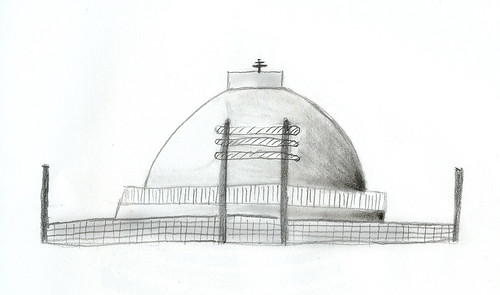
This is a sketch of a dagoba or stupa from Sri Lanka. Some of the elements, such as the fence, from the Indian stupa may be missing in the Sri lankan structure but the overall look is still quite similar. For example the Dome is still a very prominent part of the stupa.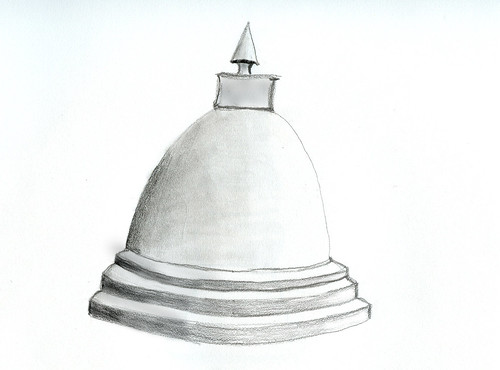
This one is a sketch of a typical chorten or Tibetan stupa. With these structures two of the most noticeable changes visually is that the dome is much smaller and the spire is much more prominent .
I found this blog recently about the construction of a stupa in Thailand. Particularly I found the article of a visiting Rinpoche (religious leader) and his talks about the importance of a stupa. According to him the purposes of building a stupa are, mainly, to better the people (eliminate "defilements" or attachments) and to receive blessings from it. Also that the pursuit of building such a structure has to be done carefully and with the right intentions.
But I guess that the main thing that struck me was the idea that the stupa didn't belong to anyone, that it was built so that everyone could be benefited. It doesn't belong to the builders, the sponsors, to the religious, it belongs to everyone who comes in contact with the stupa. I find it interesting because as an artist, I can become attached to my artwork... I mean if I work three months on a video, its mine! or at least that's how I feel. But here the idea is not to build something and say: "We made it" or "Look! this represents us!". The purpose is to help the viewer become better.
I'm so used to seeing monuments or memorials, things that in a way belong to either a country, a group of people, or an individual not because they physically own it but because they own it emotionally. It's as thought the object in a way either represents them or relates to them. I don't think that anyone would say that a veteran's memorial wouldn't in a way belong to the veteran's themselves. However, with the stupa the idea of ownership is different, they want the effect that the structure has on people to not be limited to a select group but for it to be universal. This may all sound odd, maybe even too spiritual to handle, but I think it's relevant to the arts. As an artist I may feel that my artwork belongs to me, because of my effort put into it, but we also have to acknowledge the partial ownership that the viewer has on the work. They also have a connection to the work due to them being in contact with it and I as an artist have to be conscious of the fact they are affected by it and that the message that I put in it belongs to them as well.
Posted by Unknown at 1:28 PM 0 comments
Well I don't think I have introduced myself yet; my name is Norman Javier Pérez Rodríguez but call me Norman (it's shorter and it's my name as well). As you might have guessed from my profile and this blog I'm an artist living in Ohio and I'm currently finishing my BFA (Bachelor of Fine Arts for those not in the know) in art and technology. I was born and raised in Bayamon, Puerto Rico. And because I've gotten this question when I talk about my project I'll answer it: I was actually raised as a Catholic and not a Buddhist. However I personally don't feel as though I have to be of a particular religion to study it and find some sort of value in its practices and traditions, specially if its to comment on its use of imagery and symbols. The mediums I work with are video, computer animation and digital imaging. One of the concepts I generally focus on is how our perceptions of our identity and those of others can change and even contradict themselves. I already have a few sites up that have some of my work, so please visit them, if you are curious about my work:
- my Flickr site contains some of my photo work, and although most of it isn't directly related to my major art project, I find them to be quite interesting.
- my Blip.tv site contains a few of my video works which I think relate much more to the main focus of my artwork.
Posted by Unknown at 2:05 AM 0 comments
Labels: Art, BFA, Introduction, websites
So with my project I want to be able to recreate this structure in a new way that still preserves the meaning of the symbols of a stupa. The symbols I will work with have to do mainly with the shape and structure of the stupa. The reason I want to focus more on the shape of the stupa than on the imagery because the idea of images having some sort of meaning (being symbols) is something we are used to, but the idea of architectural elements telling a story by themselves is more rare. The main elements in Buddhist architecture that have stayed in some form are the hti (the spire at the top), the harmika (square underneath the spire), the anda (the hemisphere or dome), and the base of the structure (sometimes called pesavalallu). One of the interesting thing about stupas is that they can be interpreted through different ways. The ones I will work with are:
- How the proportions of the stupa represent the individual and universal aspects of spirituality.
---- The amount of sides and the proportion of the height of the elements in a stupa are controlled so that the of the elements is preserves
---- The height of the main elements represents a third of the height and the number 3 in turn represents the universal elements of Buddhist spirituality
---- The ground plan on the other hand incorporates the number four and this represents the individual aspects.
- How the different parts represent the process of the relic being “born” in the heart of the Buddhist
---- The Dome or dhatu-gharba (womb) is where the relics are stored, then they are born through the harmika (cremation altar) and born as the hti (tree of life)
- And how the each element represents the path the Buddhist takes toward enlightment.
---- The base represents the preparatory steps to enlightenment, the dome the psychic element of enlightenment and the harmika/spire represent the realization of enlightenment.
I will make 3D model of three types of stupas and use each of them for one of the interpretations of a stupa. The video will use still images and sounds to represent different aspects of the stupas (for example, to represent the path to enlightenment interpretation each part will be substituted with images of what each part symbolizes).
Note: This is the end of my proposal series, I hope that you have learned a little bit more about the project. Right now I'm working on trying to post some of my sketches and on finishing a preliminary storyboard. If anyone out there has information on Buddhist artwork that might relate to this, please leave a comment about it.
Posted by Unknown at 11:33 AM 0 comments
In Spring of '07 I took my first History of art class, specifically I took a survey in Asian history of art. Personally I can say that I can truly recommend the class, mainly because of the way it was taught. Instead of showing a seemingly random list of artworks the professor decided to present how the different religions affected the style of the art across different regions and periods. And one of the religions that influenced the art of Asia the most was Buddhism. What I found most interesting was how elements of the religion were preserved from as different cultures were adopting it. For example: When you see images of the Buddha you will generally see an urna (its the dot you see on the forehead which is actually its a curl of hair) and the ushnisha (the protuberance on the head) and many other signs that denote him as an actual Buddha. 
Photo of a Buddha statue at Borobudur taken by Scott (SA-photo)
So on this class they also showed us how architectural elements were affected. Of the structure Buddhists built stupas were the ones that they kept building as the the religion spread. Actually Japaneses pagodas function as stupas as well, and even though they don't look almost anything like their more ancient counterparts (those built in Asia) elements such as the ritual of circumambulation, the preservation of relics inside the structure , the the layered structure, etc are still present.
Photo of a Japaneses pagoda taken by dbking
I found all of this very intriguing because I am not used to the idea that a piece of architecture can have so many meanings and that it keeps being preserved generation after generation. I also thought that if these structure were capable of preserving their meanings after hundred of years, even though their outwards appearance changed, then could it be possible to use contemporary art mediums to recreate their message? Well this seemed like a good concept to study so I decided to continue researching them, so that I may be able to construct the artwork that represents a stupa and its message.
Posted by Unknown at 5:38 PM 0 comments
Labels: circumambulating, History of Art, Stupas
Stupas are Buddhist structures constructed to house relics of the Buddha and of other influential people of the religion, and to commemorate several moments in the life of the Buddha. Their main purpose is to serve as places where the practitioner goes to be spiritually enlightened while in the presence of the relics and the stupa itself. To help achieve this out, Stupas have elaborate symbolic imagery and architecture that communicates to the viewer information about Buddhism and how they can improve their lives so they can reach Nirvana (in other words a state of spiritual perfection). For me, this intricate symbology is what attracted me to decide do this project. I find interesting that the purpose of these structures is to teach, inspire and enlighten the practitioner through the symbols they use, and that as Buddhism spread the meanings behind these symbols were preserved.
Next part: The video...
Posted by Unknown at 9:25 AM 2 comments
Note: This is the introduction to my project proposal for the first part of my project.
---For my independent-study project I plan to work on the first part of my project for my Senior exhibition. This piece will consist of representing the different symbols and imagery of a Buddhist stupa through a video-installation format while at the same time preserving their different meanings. The first part of the project will consist of making the video that will be projected on the installation and the second part will deal with the construction of the installation itself. Before I go any further I will explain what a stupa is and the reasons for making this installation.
Next part: more about stupas... tomorrow.
Posted by Unknown at 10:30 AM 0 comments
Labels: Installation, Introduction, Project proposal, Video
Well I'm back from yesterday's all-nighter. I'll say that I got quite a bit done. The proposal is almost completely done, and will be posted both here and at my sister site http://stupasinvideoclass.blogspot.com/ in chunks (its three pages long, generally proposals around here are barely one page long). I didn't do too many sketches but I'll be sure to scan post them tomorrow morning. Still no detailed storyboard but that will come soon as well. The main accomplishment was to actually get the basic concept of what the video will consist of, essentially, I plan to be make three videos (whose concepts I was also able to lay out yesterday) before the end of March. Then the installation will be completed in June in time for my Senior exhibition show.
My next posts will talk more about what I plan on doing for this project. Expect posts about my inspirations, how I got interested on this subject, etc. coming soon as well. If anyone out there is interested on these ideas about buddhist art feel free to post comments and/or email me.
Posted by Unknown at 1:28 AM 0 comments
Labels: Art, Project proposal
 Well, I think I've let my classes, blog and my project lag too much. So I've decided to do an all-nighter tonight and inject some work on my stuff. So what are the plans? Well, first to start populating my flickr account (yes I have Flickr, its awesome) with some material. In fact this image comes from my flickr account. Its a 3D model of the installation I'll be constructing during Spring of '08, to use as a projection screen for the video I'll be making now on winter of '08.
Well, I think I've let my classes, blog and my project lag too much. So I've decided to do an all-nighter tonight and inject some work on my stuff. So what are the plans? Well, first to start populating my flickr account (yes I have Flickr, its awesome) with some material. In fact this image comes from my flickr account. Its a 3D model of the installation I'll be constructing during Spring of '08, to use as a projection screen for the video I'll be making now on winter of '08.
Also, I decided to go to the Jason Salovon talk at the Columbus Museum of Art, because really when you decide to do an all-nighter you just have to go to a 7 pm lecture right before working (its not as if I have hours before my proposal is due). Actually a very interesting artist, his work is very concept based, and works with ideas such as reformatting information or data in new visual ways. Maybe I should do a more thorough post of his work later on, see how it compares to my work and what I can learn from him.
I am also going to write a proper proposal for the video part of this project, do sketches/story-board, scan these sketches, and probably do a video with these sketches (and of all these things I think the video could take the least amount of time... or at least it feels that way). Well I'm off to several hours of reading, writing and drawing, wish me luck
Posted by Unknown at 11:46 PM 0 comments
Labels: 3D, Art, Jason Salavon
 Every time I try to explain my project to people (from family, to professors, to classmates) the first question they ask is: -Wait, a what?-, followed by: -What's a Stupa?-. So lets start by explaining what they are:
Every time I try to explain my project to people (from family, to professors, to classmates) the first question they ask is: -Wait, a what?-, followed by: -What's a Stupa?-. So lets start by explaining what they are:
In Buddhism one of the most important structures they make is the Stupa. In them they keep the relics of influential Buddhists, like the historical Buddha. The purpose of these structures though is not to simply be a place to preserve these remains, but instead they are places for the Buddhist devotee to visit and be spiritually influenced by it. The basic ritual surrounding stupas consists of the person circumambulating (yeah! big word... it means to walk around) several times, each time closer to the center of the stupa. The idea behind this is that as they get closer to the relics in the stupa, it reflects how they are getting closer to achieving their goal of reaching Nirvana. Another way the stupa helps the devotee is that the stupas are covered with images whose meaning they would interpret and so be able to learn more about the religion and better their karma.
Image of the Stupa at Sanchi taken by Marc Shandro
http://flickr.com/photo_zoom.gne?id=34958707&size=m
Posted by Unknown at 1:41 AM 0 comments
Labels: circumambulating, Sanchi, Stupas
Welcome!
As you can see right now this is my first post (most definitively no my last). The purpose of this site is to function as a documentation of my future artwork involving the study of buddhist stupas. I want this blog to function as a way of documenting how this project comes about, the research behind it, the reasons and inspirations that helped create it.
Again welcome, more posts explaining the back story of this project will follow shortly have a nice day ... .... ... ... ... ... ummm still here ... ... well then I recommend coming back in a little while... ... and subscribe to my RSS feed so you stay updated on my work
Posted by Unknown at 10:46 AM 1 comments
Labels: Art, Introduction, RSS, Stupas